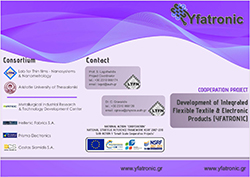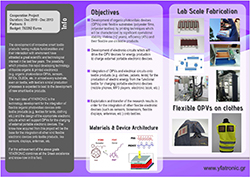Project Objectives |
|
The development of innovative smart textile products for techniques and functional applications which will have the capability to perform multiple functionalities and interact with their environment have attracted a great scientific and technological interest in the last few years. The possibility which provides this rapid developing technology of flexible organic electronics for printing electronics devices (e.g. organic photovoltaic devices-OPVs, sensors, RFIDs, organic light emitting diodes-OLEDs, etc) in almost every kind and size of substrate, even on textile, with textile’s similar production processes is expected to lead to the development of new smart textile products. For achieving this, it is crucial the successful combination of the field of textiles with the field of flexible organic electronics. The main idea of YFATRONIC is the technology development for the integration of flexible organic photovoltaic devices onto textile products (e.g. textiles for tents, clothing etc.) and the design of the appropriate electronic circuits which will support OPVs for the charging of external portable electronics devices. The know-how acquired from this project will be the base for the integration of other kind flexible electronic devices onto textile products, like sensors, displays, antennas, etc. For the achievement of the above goals YFATRONIC combines all the Greek excellence and know-how in this field. More specific the goals of YFATRONIC are: 1. The development of organic photovoltaic devices (OPVs) onto flexible substrates (polyester films, polyester textiles) by printing techniques which will be characterized by significant operational stability, long lifetime (1-2 years), high efficiency (4-5%) and the their flexible use on textile products (e.g. clothes). 2. The development of electronic circuits which will drive the OPV devices for the utilization of the energy produced to charge external portable electronic devices. 3. The integration of OPVs and electrical circuits onto textile products (e.g. clothes, jackets, tents) for the passive production of electric energy from the functional textile and its use for charging portable electronic devices (mobile phones, MP3 players, electronic book, etc). 4. The exploitation and transfer of the results for further research on the field for the integration of other flexible electronic devices onto textiles, such as sensors, biosensors, flexible displays, antennas, etc. |



